9.1 Crypto Mining: What It is and How Does It Work?
Free Airdrop Season 7 is LIVE! Answer fun questions or do simple tasks to earn rewards from the $30K BitDegree prize pool. Participate Now ! 🔥
In this section, we’re going to look into what is crypto mining, and how does crypto mining work!
If you’re reading this section, it means that you’ve had enough of hearing about crypto mining everywhere, and decided to finally tackle the question of “what is crypto mining” once and for all. That’s a good call, since mining is a fascinating and dynamic aspect of the cryptocurrency world, and it plays a vital role in the creation and security of many digital assets.
Even though this subject can get pretty polarizing, it still remains a fundamental pillar of the decentralized nature of cryptocurrencies. And you’re about to understand what makes this topic so interesting, yet so dividing, as well.
In this section, we’re going to look into the questions of what is crypto mining, how does crypto mining work, what kind of crypto mining software and hardware miners require, and everything else that’s related to the topic. For beginners, these questions may seem headache-inducing, but you can’t venture into the land of crypto without knowing the answers to them.
Without any further ado, let’s grab that virtual pickaxe and get to work.

Video Explainer
Video Explainer: Crypto Mining: What It is and How Does It Work?
Reading is not your thing? Watch the "Crypto Mining: What It is and How Does It Work?" video explainer
Crypto Mining Explained: How to Earn From Mining Bitcoin? (Animated)


What is Crypto Mining?
Starting from the very beginning, we should probably define the concept, first. So, what is crypto mining?
In its essence, crypto mining is the process that is used to create new digital coins, verify new transactions, and add them to the blockchain ledger. Many cryptos, and most importantly - Bitcoin, rely on crypto mining, because it’s thanks to mining that these currencies enter circulation in the shape of new, freshly-mined coins.
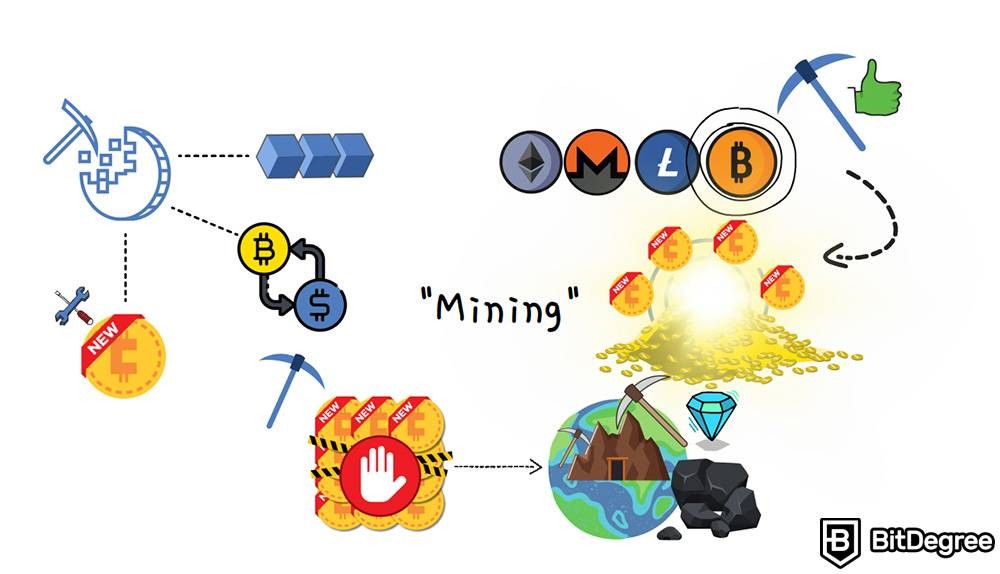
That’s where the term "mining" comes from, since there is a limited number of new coins that can be “extracted”, or “mined”, same as with mineable natural resources in the real world, such as diamonds or coal.
Technically, crypto mining is part of something that’s known as a “consensus mechanism”.
A consensus mechanism is like a rulebook for how a blockchain operates. Different blockchain networks have different consensus mechanisms, which ensure that all network participants reach an agreement on what things should look like without the need for a central authority.
Let’s consider chess. Chess has its rules, and people simply follow them. There’s no need for a referee to sit beside and make sure that no one’s gonna begin making checkers’ moves with chess figures.
When it comes to the “rules of the blockchain”, this means that a consensus mechanism serves the purpose of ensuring that all the blockchain network participants agree on the validity of transactions and the state of the network. Different blockchains have different consensus mechanisms, and some of them don’t require mining in order to be functional.
By the way, it’s impossible to understand this without having a decent understanding of what a blockchain is. If you feel like you could refresh your knowledge about them, be sure to check out this section! Okay, now back to consensus mechanisms.
The consensus mechanism that relies on mining is known as Proof-of-Work, or, more commonly, PoW.
To explain PoW in simple terms, we can imagine a running competition. The fastest wins the race. In terms of crypto mining, this translates to “the fastest miner wins the reward”. Here’s what I mean.
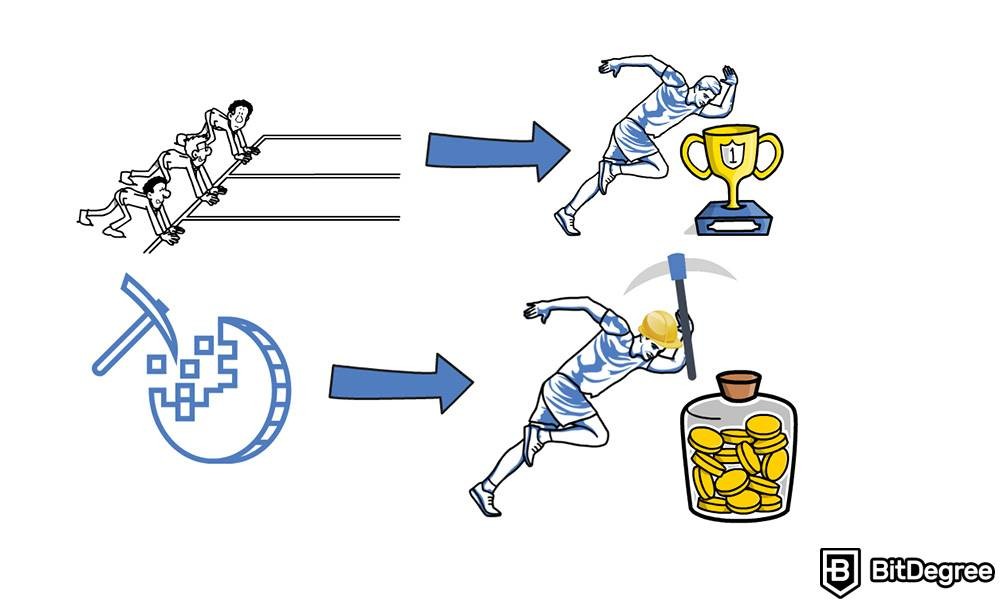
PoW involves miners competing to solve complex mathematical puzzles. These puzzles are known as hashes. Hashes are 64-digit numbers, and in order to find the right hash, miners have to put in quite a lot of effort. But this effort isn’t physical or mental. It’s pure computational power that requires a lot of electricity.
In addition to mining, this computational effort is used to ensure the security of the network, constantly monitor the integrity of transactions, and make it near impossible for malicious actors to manipulate the blockchain's transaction history.
So, that’s the definition of Proof-of-Work, the consensus mechanism. But, as you’ll soon see, understanding PoW is almost the same as understanding crypto mining as such. However, enough talking about consensus mechanisms, let’s get back to the concept of mining.
In itself, the mining process has nothing to do with pickaxes, or even mining, in general. It’s something way less exciting, since it’s literally just machines solving complex mathematical puzzles 24/7.
And these puzzles can get really, really difficult. Therefore, efficient and profitable crypto mining is almost impossible without having access to the latest, state-of-art pieces of equipment. And it can get pretty expensive!

But there’s logic to it. Investing in a crypto mining rig should lead to getting these puzzles solved, which would then lead to the miners receiving an award for their efforts and investments. And this award comes in the shape of the cryptocurrency that’s native to the blockchain that miners are working on.
Once again, the most important minable cryptocurrency is Bitcoin, therefore, whenever miners solve these complex problems on the Bitcoin network - they receive some Bitcoin as a reward. Or, in other words - they successfully mine Bitcoin.
When cryptocurrencies were just kicking off, no expensive gadgets were necessary in order to participate in crypto mining. But today, special crypto mining software, combined with such hardware units as ASICs (Application-Specific Integrated Circuits), or GPUs (Graphics Processing Units), are no longer enough! Crypto miners set up entire warehouses full of high-tech crypto mining rigs just so they could participate in the crypto mining race.
Therefore, Bitcoin mining has become a less accessible activity for most people, since setting up a crypto mining rig and installing the necessary crypto mining software would lead to heavy costs, and a constantly high electricity bill.

Yet, it still remains on the menu for those who want to experience this process fully. There are many other cryptocurrencies that are still very much available for mining, even without having access to expensive crypto mining rigs. In many cases, owning a laptop, a PC, or investing into an ASIC can be enough to begin your mining journey.
Therefore, when we talk about crypto mining profitability, it depends on the cryptocurrency. Nevertheless, before jumping into it, be sure to look up a specialized crypto mining calculator that would allow you to evaluate whether such an investment would be a smart move!
Recently, when Bitcoin went through a decrease in its value, there have been many stories about crypto miners facing problems, debts and downfalls, and even bankruptcies. This industry can get really rough!
Okay, so that’s what crypto mining looks like in theory. Let’s get practical. Let’s consider the importance of crypto mining when it comes to something as big and important as Bitcoin.
Crypto Mining & Bitcoin
As mentioned earlier, crypto mining, or, in this case, Bitcoin mining, is the process of validating Bitcoin transactions and adding them to the Bitcoin blockchain, or, as it’s often referred to, the public ledger that holds all transactions that have taken place on the network.
In the process of doing so, Bitcoin mining allows new Bitcoin to be created, and ensures the security of the entire network. It’s like the cement that holds the blockchain’s bricks, or blocks, together, and allows the further construction of this colossal Web3 skyscraper.
Here’s how it works. Imagine someone makes a transaction on the Bitcoin network. Now, the information about this particular transaction has to be recorded on the blockchain - the public ledger. That’s necessary in order to make sure that any attempts at tampering with the transaction history, and any instances of fraud, would be blocked.
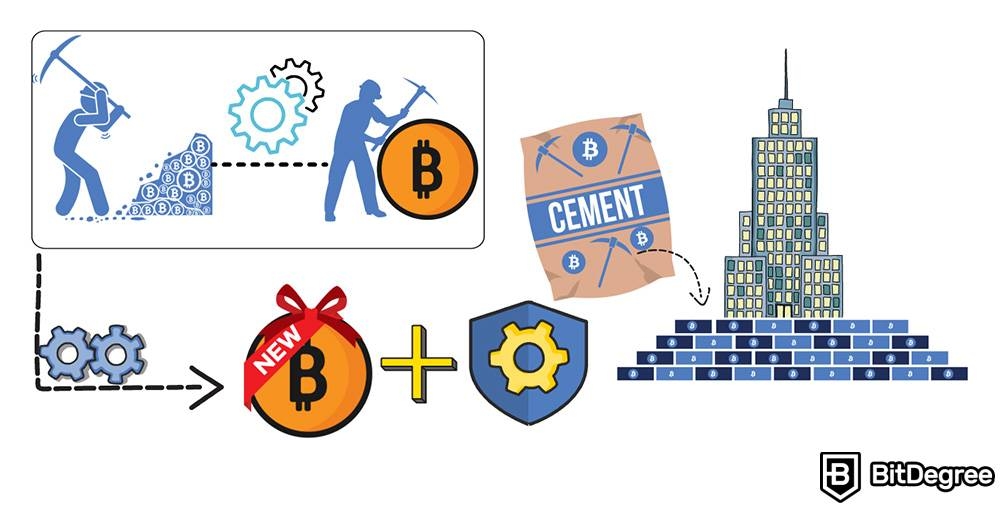
In order for this transaction to be inscribed into the blockchain, it has to be written into a block that would then be added to the network. When an old block is filled, a new block has to be created, thus continuously forming the chain of blocks - the blockchain.
And this is where the miners come in. Adding the newly-created block into the blockchain requires miners to find the already mentioned “hash.” You can view these hashes as a sort of a unique identifier, a block’s ID card that makes it possible for every validator to recognize and verify these blocks and their order within the blockchain.
Whenever a new block is about to be added to the blockchain, a new hash has to be found, which would correspond with the previous block’s hash. This process establishes a chronological order of transactions and creates a secure transaction history.
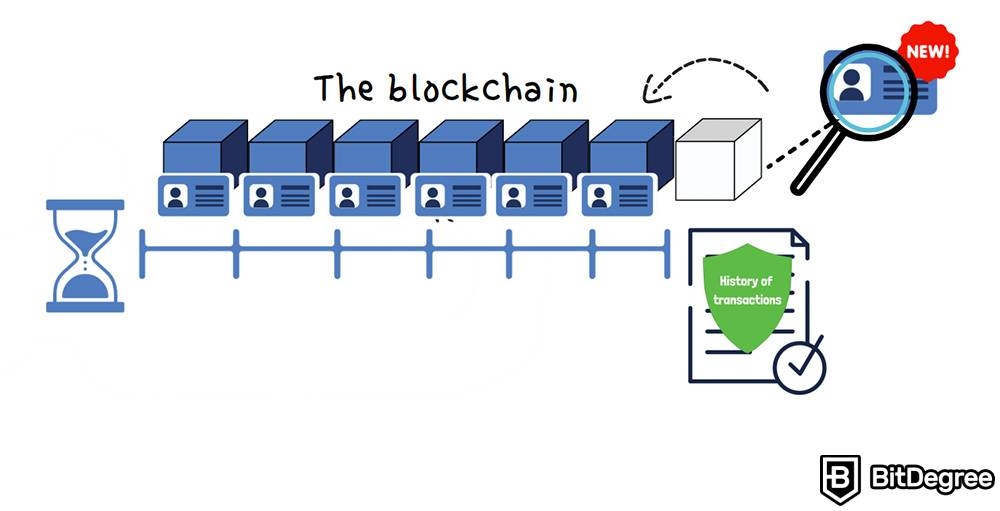
Therefore, in order to calculate it correctly and on time, miners must rely on the previously-described specialized crypto-mining software and hardware. Bitcoin users want to see their transactions verified ASAP; thus, fast and efficient machinery is required to reduce the hash-finding time.
Now, this means that transaction validation is directly dependent on miners. But, as you can see, the blockchain and the creation of new blocks also depend on them! Therefore, it only makes sense that the hard work of miners gets rewarded. And these rewards are known as “Block Rewards.”
Whenever a miner successfully adds a new block to the blockchain, they are rewarded with newly minted Bitcoin. Since that’s a lot of money, it allows miners to invest into their crypto mining rig and software, while still remaining profitable.
Problems & Criticism
As you can see, crypto mining can get really intense. And when you have so much machinery that’s running all year long… you end up with rather high electricity bills, and some giant environmental problems. That’s where the main source of criticism towards crypto mining comes from.
Critics argue that the energy consumption that comes from mining Bitcoin contributes to carbon emissions, accelerates climate change, and intensifies the usage of fossil fuels and fossil fuel-based energy sources, which, of course, emits greenhouse gases.
Then, as you may have already realized, the industry heavily relies on constant upgrades of the hardware that’s used for mining. This means that all the machinery that becomes obsolete simply turns into e-waste, thus further contributing to the environmental problems that arise from Bitcoin mining.
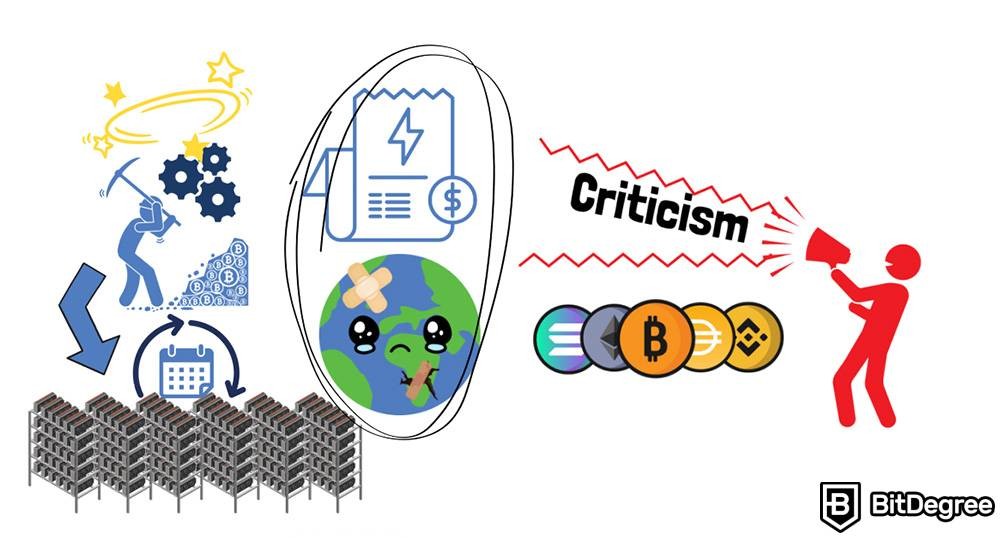
So, it’s not rocket science to reach a conclusion that crypto mining may not be a truly sustainable solution in the long run.
Of course, as the industry evolves, new ways of mining, new consensus mechanisms, and new ways of validating transactions and securing the blockchain are being created, as well. Yet, Bitcoin prevails as the number one crypto in the world, and crypto mining is almost always synonymous with “Bitcoin mining.” Besides, Bitcoin is not going anywhere anytime soon.
Therefore, it’s important to be well-versed when it comes to understanding crypto mining, because this question is sure to be the center of many heated debates in the near future.
Wrapping Up
Having said this, we reached the end of the section! By now, I hope, you’ve got a better understanding of what is crypto mining and how does crypto mining work. Also, keep in mind that, instead of a pickaxe, you’d need proper crypto mining software and to set up a crypto mining rig to be able to participate in this activity!
Even though this industry can be profitable, and it allows many blockchains to actually function in a decentralized way, it nevertheless faces many questions, dilemmas, and problems. Therefore, whenever crypto mining is being considered, the educated thing to do is to be aware of both sides and seek the best solution for everyone.










